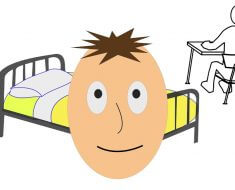The role of serotonin in brain function
Serotonin, or 5-hydroxytryptamine, is a neurotransmitter involved in many brain and body functions and is commonly known as the substance of well-being and happiness.Serotonin is produced in specialized neurons found mostly in the Raphe nuclei located along the midline of the brainstem.The axons of these neurons form extensive serotonergic pathways that reach almost every part of the central nervous system, including the cerebellum and the spinal cord.This is why it’s not surprising that serotonin is implicated in a vast array of brain functions, including sleep and wake cycle, appetite, mood regulation, memory and learning, temperature control, … among others.Serotonin is synthesized from the amino acid tryptophan and is stored in small vesicles within the nerve terminal.When a serotonergic neuron is stimulated, serotonin is released into the synaptic cleft where it binds to and activates serotonin-receptors on the postsynaptic neuron.
The Role of Serotonin in Brain Function
Serotonin action is then TERMINATED via removal of its molecules from the synaptic space.This is accomplished through a special protein called serotonin-transporter.Low levels of serotonin in the brain have been associated with depressive disorders and current treatments for depression aim to increase these levels.The most commonly prescribed medications, called “selective serotonin reuptake inhibitors”, or SSRIs, act by blocking serotonin reuptake by the transmitting neurons.This results in elevated levels of serotonin in the synaptic space and its prolonged action on the receiving neuron.The SSRIs have developed into the drugs of choice because they produce fewer side effects thanks to their selective action on serotonin alone and no other neurotransmitters.Unfortunately, because serotonin is involved in a wide range of brain functions, the side effects remain significant and may progress to a potentially dangerous condition known as “serotonin syndrome”.
Serotonin Syndrome: When Drug Use Causes Dangerous Mood Swings
This syndrome is generally caused by a combination of two or more drugs used to raise the serotonin levels in the brain.If the medications are not discontinued, the condition may become fatal.Nonpharmacologic methods of raising brain serotonin have shown promising results in recent studies.It has been suggested that positive mood induction, either self-induced or due to psychotherapy, correlates with INCREASED serotonin synthesis in the brain.The interaction between serotonin synthesis and mood may therefore be 2-way, with serotonin influencing mood and mood influencing serotonin.Other methods include exposure to bright light and tryptophan-rich diets.To note, however, that serotonin-rich food such as bananas would NOT work because serotonin, unlike tryptophan, can NOT cross the blood brain barrier.Finally, although it sounds like a cliché, physical exercise maybe the most effective and safest way of improving mood.
Serotonin Levels Increase Following Vigorous Physical Activity
Several studies suggest that serotonin levels are increased with vigorous physical activity and that these elevated levels are maintained for several days after the exercise..
Read More: These Simple Things You Can Do Right Now to Feel Happy






